Strange and Weird Looking Frogs
Explore and find out more about these frogs
| Back to Frogs | Main Menu | Teacher's Corner |
| Kid's Corner | Holidays & Celebrations | Other Themes |
WE HAVE MOVED TO A NEW URL. REORGANIZING.
PLEASE BOOKMARK OUR NEW URL
http://kiddyhouse.com/themes/frogs/strange-frogs/
YOU WILL BE REDIRECTED TO THE NEW URL
OR CLICK HERE TO GO THERE
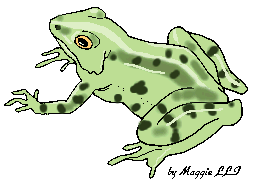
|
There are many different species of frogs out there. Some are a little strange looking, make weird sounds or have amazing characteristics. Below are some examples for you to check out.
Glass Frog
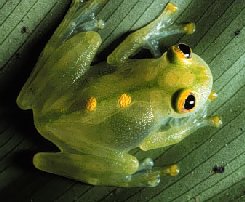
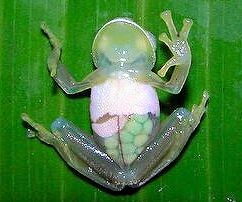
Image credit goes to http://www.arkive.org/giant-glass-frog/centrolene-antioquiense/image-G109200.html
The glass frog is strange because you can see the insides of its body. You can see the heart beat , the bones, muscles and organs. The abdominal side of the skin is translucent or see through. Its color is green or lime green. There are more than 50 species of glass frogs. They are about 1.2 and 3.0 inches long. They live along streams and rivers in Central and South America.
Vietnamese Mossy Frog
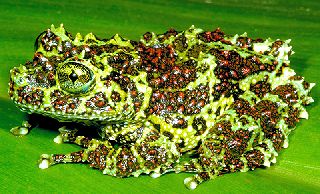
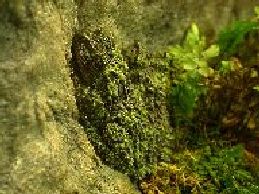
(image credit goes to: http://most10s.blogspot.com/2013/04/blog-post_22.html)
Vietnamese mossy frogs are so called because they practically look like they are covered in moss. It is a great camouflage to protect themselves from predators. They just blend into the mossy environment. They are found in the mountains of northern Vietnam. They live in the flooded caves and banks of mountain streams. They grow to about 2.5 and 3.5 inches long. They are very good tree climbers.
Purple Frog
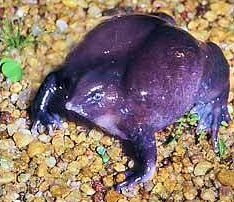
|
Purple frogs are also known as the pig-nosed frog. They grow to about 3 inches in length. They were discovered in 2003 in the Idukki district of Kerala and are very rare. They are listed as under the endangered species. They have purple colored skin on the top and grayish on the abdomen. They are burrowing frogs. Purple frogs will burrow 4 to 12 feet underground to search for food. Their main diet are the termites, worms and ants. They live underground and come out of their burrow only during the monsoon season to breed.
Harlequin Toads/Frogs
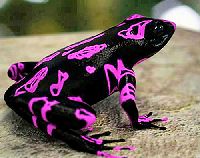
The harlequin frogs here were thought to be extinct in Costa Rica. However, they have been rediscovered in the Talamanca Mountains of southern Costa Rica. They are still a critically endangered species. The harlequin frog is a species of the poison dart frog.
The harlequin frogs are weird because their tadpoles feed on eggs. The mother comes back to lay unfertilized eggs for them to eat until they are ready to leave the water.
Venezuella Pebble Toad
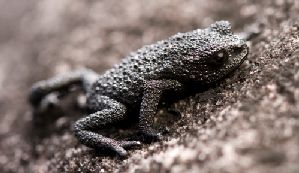
Image credit goes to
The Venezuela pebble toads are found in the Amazon rainforest of South America. The texture of its skin is rough and the color is black and gray, resembling pebbles.
They have a strange defence mechanism. When in danger, it folds its arms and legs, tucks in the head, tense up the muscles to look like a ball and bounce down the hill to get away. Predators will find it hard to see them because they now look like a dislodged pebble.
The pebble frog also shares a communal nest to lay their eggs.
Turtle Frog
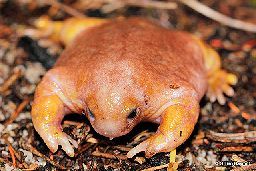
Image credit goes to flickr.com/photos/gillbasnett/8085123683/
Turtle frogs are found in the southwest and central zones of west Australia. They live in semi arid environment and are usually close to termite colonies. They like to hide under logs and stay underground and only come out after the rain to mate. They will go back into their burrow once they have found their mates. Turtle frog eggs do not hatch into tadpoles. They develop into frogs in the eggs. They have short and strong limbs that allow them to dig into the ground. Turtle frogs also dig like a turtle. It digs forward rather than backwards. An adult is about 2 inches long.
Wallace's Flying Frog
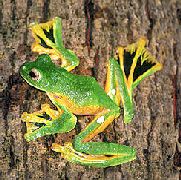
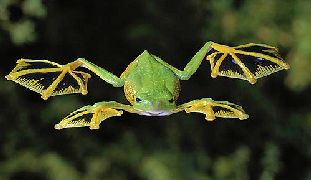
Image credit goes to thesun.co.uk/sol/homepage/news/5122955/Air-of-the-flying-frog.html
Wallace's flying frogs are also called parachute frogs. They are found in the tropical rainforest of Malaysia and Borneo. They live on trees but come down to mate and lay eggs. These frogs can leap and glide for 50 feet or more. They splay their huge webbed feet as they leap to catch the air as they fall and glide.
Water Holding Frog
The water holding frog is really amazing. They are found in the Australia except in the states of Victoria and Tasmania. It will bury itsself upto 3 feet underground in the desert and only come up to the surface after a heavy rain to breed. The water holding frog seals itself in a water-tight, mucus cocoon when it is underground. It has a bladder that has the ability to store fresh water.
Watch the video of the water holding frog below.
Pinocchio nose frog
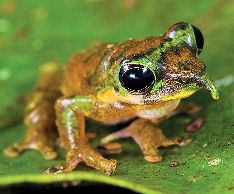
|
A team of scientists discovered a frog with a Pinocchio-like nose in the remote Foja Mountains of Indonesia. The nose of the male Pinocchio nose frog points upward when it is excited with energetic calls. It deflates and points downward when it is not that excited.
Desert Rain Frog
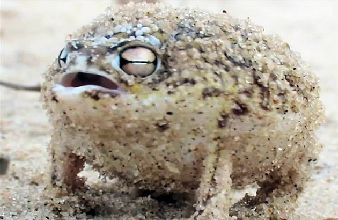
Image credit goes to Dean Boshoff
Desert rain frogs do not croak. Instead, they make this strange "squeaking" sound. They are found in South Africa's Northern Cape. It eats spiders and other insects. They grow to almost 2 inches long. They spend most of their lives buried under the sand but comes out to feed at night. They lay their eggs in underground chambers. The eggs are covered in a thick jelly. The jelly will soften into a fluid once the eggs hatch into tadpoles to allow them fully grow into a frog. This makes it less dependent on water to survive.
Surinam Toad

Image credit goes tof
Surinam Toad Babies Emerging
DISCLAIMER : This is a disclaimer. We try to gather information that are
as accurate as possible. However, if there are mistakes, we will not be held
liable for anything. Use it at your own discretion.
IMPORTANT : We are not responsible for any links beyond our site.


